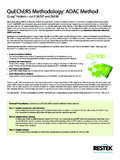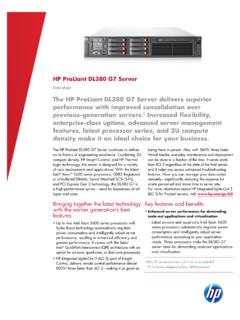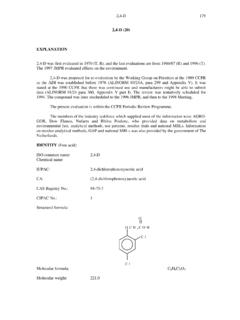Transcription of Use of the CMOS Unbuffered Inverter in Oscillator …
1 Application ReportSZZA043 - January 20041 Use of the cmos Unbuffered Inverter in Oscillator CircuitsMoshiul Haque and Ernest CoxStandard Linear & LogicABSTRACTCMOS devices have a high input impedance, high gain, and high bandwidth. Thesecharacteristics are similar to ideal amplifier characteristics and, hence, a cmos buffer orinverter can be used in an Oscillator circuit in conjunction with other passive , cmos Oscillator circuits are widely used in high-speed applications because they areeconomical, easy to use, and take significantly less space than a conventional the cmos devices, the Unbuffered Inverter ( U04) is widely used in oscillatorapplications. This application report discusses the performance of some TI U04 devices ina typical crystal- Oscillator .. 2 Theory of Oscillators3.. Characteristics of Crystals3.. 3 Buffered and Unbuffered cmos Inverters in Oscillator Circuits6.
2 4 Characteristics of a cmos Unbuffered Inverter7.. Open-Loop Gain7.. VO vs VI8.. ICC vs VI9.. Variation of Duty Cycle With Temperature10.. 5 Characteristics of LVC140411.. 6 Practical Oscillator Circuits12.. Selection of Resistors and Capacitors13.. RF13.. RS13.. C1 and C216.. 7 Practical Design Tips16.. Appendix A. Laboratory Setup18.. Laboratory Setup to Measure Open-Loop-Gain Characteristics18.. Laboratory Setup to Measure ICC vs VI Characteristics18.. Appendix B. LVC1GU04 in Crystal- Oscillator Applications19.. LVC1GU04 in 25-MHz Crystal- Oscillator Circuit19.. LVC1GU04 in 10-MHz Crystal- Oscillator Circuit20.. LVC1GU04 in 2-MHz Crystal- Oscillator Circuit21.. LVC1GU04 in 100-kHz Crystal- Oscillator Circuit22.. Trademarks are the property of their respective of the cmos Unbuffered Inverter in Oscillator CircuitsAppendix C. LVC1404 in Crystal- Oscillator Applications23.
3 LVC1404 in 25-MHz Crystal- Oscillator Circuit23.. LVC1404 in 100-kHz Crystal- Oscillator Circuit24.. List of Figures1 Oscillator3.. 2 Electrical-Equivalent circuit of a Crystal4.. 3 Pierce Oscillator Using cmos Inverter5.. 4 Open-Loop-Gain Characteristics of LVC1GU046.. 5 Open-Loop-Gain Characteristics of AHC1GU046.. 6 Open-Loop-Gain Characteristics of AUC1GU047.. 7VO vs VI Characteristics of LVC1GU047.. 8VO vs VI characteristics of AHC1GU048.. 9VO vs VI Characteristics of AUC1GU048.. 10 ICC vs VI Characteristics of LVC1GU048.. 11 ICC vs VI Characteristics of AHC1GU0410.. 12 ICC vs VI Characteristics of AUC1GU0410.. 13 Duty-Cycle Variation in LVC1GU0410.. 14 Duty-Cycle Variation in AHC1GU0411.. 15 Duty Cycle Variation in AUC1GU0411.. 16 Pinout Diagram for LVC140411.. 17 Logic Diagram of LVC140412.. 18 Open-Loop-Gain Characteristics of LVC140412.. 19 Pierce Oscillator circuit Using Unbuffered cmos Inverter13.
4 20 Effect of RS on Oscillator Waveform (No Load)14.. 21 Effect of RS on Oscillator Waveform (RL = 1 kW)14.. 22 Effect of RS on the Frequency Response of Feedback Network15.. 23 Effect of RS on the Phase Response of Feedback Network15.. 24 Oscillator circuit Using a Schmitt-Trigger Input Inverter17.. A-1 Open-Loop-Gain Measurement Setup18.. A-2 ICC vs VI Measurement Setup18.. B-1 Effect of RS on Duty Cycle and ICC (Frequency = 25 MHz)19.. B-2 Effect of RS on Duty Cycle and ICC (Frequency = 10 MHz)20.. B-3 Effect of RS on Duty Cycle and ICC (Frequency = 2 MHz)21.. B-4 Effect of RS on Duty Cycle and ICC (Frequency = 100 kHz)22.. C-1 Output Waveform of Oscillator circuit Using LVC1404 (Frequency = 25 MHz)23.. C-2 Output Waveform of Oscillator circuit Using LVC1404 (Frequency = 100 kHz)24.. List of TablesB-1 Effect of RS on Duty Cycle and ICC (Frequency = 25 MHz)19.. B-2 Effect of RS on Duty Cycle and ICC (Frequency = 10 MHz)20.
5 B-3 Effect of RS on Duty Cycle and ICC (Frequency = 2 MHz)21.. B-4 Effect of RS on Duty Cycle and ICC (Frequency = 100 kHz)22.. SZZA0433 Use of the cmos Unbuffered Inverter in Oscillator Circuits1 IntroductionResistors, inductors, capacitors, and an amplifier with high gain are the basic components of anoscillator. In designing oscillators , instead of using discrete passive components (resistors,inductors, and capacitors), crystal oscillators are a better choice because of their excellentfrequency stability and wide frequency range. A crystal basically is an RLC network that has anatural frequency of of OscillatorsIn principle, an Oscillator can be composed of an amplifier, A, with voltage gain, a, and phaseshift, , and a feedback network, F, with transfer function, f, and phase shift, (see Figure 1).V1V2 Amplifier, Aa, aFeedback Network, Ff, bFigure 1. OscillatorFor |f| |a|w1 the oscillating condition is fulfilled, and the system works as an and a are complex quantities; consequently, it is possible to derive from equation 1|f| |a| exp j a)b w1 the amplitude|f| |a|w1and the phase a)b +2 pTo oscillate, these conditions of amplitude and phase must be met.
6 These conditions are knownas the Barkhausen criterion. The closed-loop gain should be 1, and the total phase shift of 360degrees is to be of CrystalsFigure 2 is an electrical-equivalent circuit of a quartz crystal. (1)(2)(3)SZZA0434 Use of the cmos Unbuffered Inverter in Oscillator CircuitsC0 RLCF igure 2. Electrical-Equivalent circuit of a CrystalThe quantities C and L are determined by the mechanical characteristics of the crystal; R is theresistance of the resonant circuit at the series resonance, and Co represents the capacitance ofthe leads and electrodes. Co is much larger than C and is affected by the stray capacitances ofthe final circuit . Because R is negligible, the impedance of this circuit is given by equation +jw w2LC*1(Co)C)* w2 LCCo A series-resonance frequency is attained when the impedance, Z, approaches 0, Z 0 LCfserp21=A parallel-resonance frequency is attained when the impedance, Z, approaches , Z oserparCCff=1 +An Oscillator circuit using the parallel resonance mode of the crystal is less stable than theequivalent circuit using the series resonance, because of the dependence on the external circuitparameter.
7 For series resonance, the crystal appears as a series-resonant resistance, R. Forparallel resonance, the crystal appears as an inductive the Oscillator circuit , the crystal acts as the feedback network. For proper operation, the inputimpedance of the amplifier should be well matched to the low series-resonant resistance of thecrystal. For HCMOS devices, because of the high input impedance, a crystal operated in seriesresonance would be completely mismatched. The solution is to operate the crystal inparallel-resonance mode. But, parallel resonance has a poor frequency response compared toseries resonance because of the dependence on Co (stray capacitance or circuit capacitance).Connecting a capacitance in parallel (CP) with the crystal can reduce the influence of Co on theparallel-resonance frequency. From the equation of the parallel-resonance frequencyopparCCCLCf+=1 +21p(4)(5)(6)(7)SZZA0435 Use of the cmos Unbuffered Inverter in Oscillator CircuitsBy choosing CP > Co (Co is approximately 3 pF to 5 pF, and CP typically is 30 pF).
8 CP >> C (C is in the range of femtofarads)LCfparp21 Now, the parallel-resonance frequency is approximately equal to the popular application of the parallel-resonance circuit is the Pierce Oscillator circuit (seeFigure 3) in which the parallel combination of C1 and C2 constitutes + CCCCCP=C1 and C2 form a capacitor voltage divider that determines the degree of feedback. Thefeedback factor is given byf+C1C2 RFCMOS InverterCrystalC2C1 Figure 3. Pierce Oscillator Using cmos InverterThe optimal value for Cp determines the quality and frequency stability of the crystal , the crystal manufacturer s data sheet specifies the recommended load for the crystal(CL). Cp represents the load for the crystal, and this should be equal to CL, as specified in thecrystal manufacturer s data an Oscillator circuit , the cmos Inverter operates in the linear mode and works as an phase shift provided by the Inverter is 180 degrees.
9 To meet the oscillating condition, thecrystal Oscillator must provide an additional 180 degrees of phase shift. If C1 = C2, currentthrough them is identical and 180 degrees out of phase from each other. Hence, for C1 = C2, thecrystal provides a phase shift of 180 degrees. The feedback resistor modifies the input impedance of the cmos Inverter . For an Inverter withan open-loop gain much higher than 1, the input impedance becomes(8)(9)(10)SZZA0436 Use of the cmos Unbuffered Inverter in Oscillator CircuitsZi+RFaThe parallel-resonance resistance of the crystal is modified by the load capacitor, )(C1pop+ CRR=wRp should match the input impedance of the cmos Inverter . For example, if a crystal oscillatorhas the following parameters:Cp = CL = 30 pFCo = 7 pFR = 80 at 5 MHzRp+1 80 2 p 5 106 2 30 10*12)7 10*12 2 From the calculationRp[10kWRp should be equal to Zi, ,Zi+Rp+10kWZi+RFa+10kWaRZFi== 10 k RF+10kW aFor a cmos Inverter with an open-loop gain, a = 100, the value of the feedback resistor iscalculated as:RF+10000 100+1 106+1 MWBy using a feedback resistor of 1 MW, successful oscillation can be accomplished.]
10 In practicalapplications, the value of the feedback resistor usually will be greater than 1 MW in order toattain higher input impedance, so the crystal can easily drive the and Unbuffered cmos Inverters in Oscillator CircuitsUnbuffered inverters have a single inverting stage, and the gain of this type of Inverter is in therange of hundreds. Buffered inverters have more than one stage, and the gain is in the range ofseveral thousand. In the buffered Inverter , power consumption usually is less than in theunbuffered Inverter , because the first and the second Inverter stages consume significantly lesspower-supply current than the output stage. Because the first stage remains in linear modeduring oscillation, a buffered Inverter consumes less power than an Unbuffered Inverter . Bothbuffered and Unbuffered inverters can be used for Oscillator applications, with only slight designchanges. Because the gain of buffered inverters is very high, they are sensitive to parameterchanges in the Oscillator circuit and are less stable than Unbuffered inverters.


















